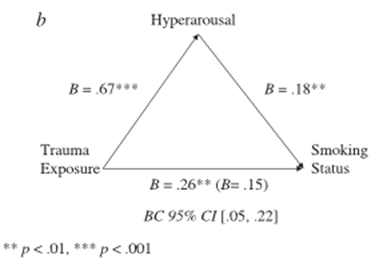ASHES, Vol. 11(10) – Smoking among college students with trauma exposure: The mediating role of PTSD symptoms
Anti-smoking efforts on college campuses commonly highlight the negative health effects associated with smoking and the need to reject social pressures to smoke. College students experiencing PTSD symptoms might need special attention, because people who have experienced trauma tend to be more likely to smoke (Roberts et al., 2008). In this week’s ASHES, we review a study that explores whether PTSD symptoms mediate the relationship between trauma exposure and smoking among college students (Gabert-Quilen et al., 2014).
Methods
- The researchers recruited college students attending psychology courses at a single University to complete a questionnaire for course credit.
- Three hundred and twenty nine college students reported one or more trauma experiences and were included in the current study.
- The questionnaires included the following questions and scales:
- Current smoking status
- Post-traumatic Stress Diagnostic Scale, which asks 48 questions about trauma exposure and past month symptom severity and can be used to determine if participants have a probable PTSD diagnosis.
- The researchers used regression analyses to investigate whether there was a relationship between number of traumatic exposures and smoking status, and whether that relationship was mediated by (a) number and severity of PTSD symptoms endorsed, and (b) specific PTSD symptom clusters (e.g., hyperarousal).
- The models controlled for gender, age , and time since trauma event.
Results
- Fifteen percent of the total sample were current smokers and 8.7% had a probable PTSD diagnosis.
- Participants with probable PTSD diagnosis were more likely to report being smokers than those without (28% vs. 15%).
- As Figures 1a and 1b show, trauma exposure significantly predicted smoking status, and that relationship was mediated by PTSD symptoms in general, and hyperarousal symptoms in particular.
Figure 1. (a) Mediation model examining the relationship between trauma exposure, PTSD symptoms, and smoking status. (b) Mediation model examining the relationship between trauma exposure, hyperarousal symptoms, and smoking status (Reproduced with permission from Stress Health).
Note. Consider the relationship between trauma exposure and smoking status, which is shown on the bottom line of each figure. Initially, both (a) and (b) show a significant relationship between trauma exposure and smoking status (in both cases, B = 0.26**). The B in parentheses represents the relationship between trauma exposure and smoking status when the model includes (a) PTSD symptoms or (b) hyperarousal. The B decreases and becomes non-significant, suggesting mediation by PTSD symptoms and hyperarousal, respectively. The BC 95% CI (i.e., bias corrected 95% confidence interval) reports on a specific test of mediation. In both cases, the CI does not include 0, indicating a significant mediation effect.
Limitations
- Because this was a cross-sectional study, we cannot conclude whether smoking behavior preceded the traumatic exposure or symptoms, or whether there was a direct causal link between exposure, symptoms, and smoking.
- The sample was predominantly female (83%), so the findings might not generalize to male college students.
Conclusions
The current study shows that the relationship between past trauma exposure and college student smoking is mediated by PTSD symptoms, specifically hyperarousal symptoms. This finding contributes to previous research suggesting that smoking is used as a form of coping with hyperarousal and PTSD symptoms, and extends that research to college students. Treatment of to PTSD symptoms, specifically hyperarousal symptoms, could increase the efficacy of campus smoking interventions. Further research should examine these relationships across time and test whether interventions that target coping skills can reduce these associations among college smokers with previous trauma exposure.
— Kelly Chen
What do you think? Please use the comment link below to provide feedback on this article.
References
Gabert-Quillen, C., Selya, Al, & Delahanty, D. (2014). Post-traumatic Stress Disorder Symptoms Mediate the Relationship Between Trauma Exposure and Smoking Status in College Students. Stress Health, 78-82.
Roberts, ME, Fuemmeler BF, McClernon FJ, Beckham, JC (2008). Association between Trauma Exposure and Smoking in a Population-Based Sample of Young Adults. Adolescent Health, 266-274.

